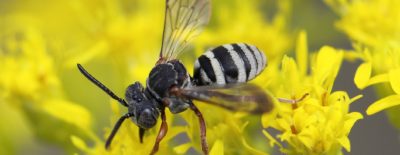Cellophane-cuckoo Bees are obligate cleptoparasites of Cellophane Bees (Colletes). Most are host specific and target one of the summer or fall Cellophane Bee. Two species make up the vast majority of the records for Vermont, but several other rare species are present and likely to be identifiable from photos.
Genus level ID – These black and white bees form a distinct group with Long-horned Cuckoo Bees (Genus Triepeolus). Some species in both genera are distinctive, but other individuals are hard to assign to genus from photos. Cellophane Cuckoo Bees tend to be smaller and most species have small red patches on the thorax (unlike Long-horned Cuckoos).

Notch-backed Cellophane-cuckoo Bee (Epeolus scutellaris)
Probably the most abundant Epeolus in VT. Primarily active in August, often on goldenrod.

Two-banded Cellophane-cuckoo Bee (Epeolus bifasciatus)
One of our most distinctive bees. Usually found in weedy fields and around farms and gardens, July and August.

Canadian Cellophane-cuckoo Bee (Epeolus canadensis)
Regionally rare. Known from one sandy site in Chittenden County, late June and early July.

Least Cellophane-cuckoo Bee (Epeolus minimus)
Regionally rare. Known from one sandy site in Chittenden County, late June.

Dwarf Cellophane-cuckoo Bee (Epeolus pusillus)
Rare to very rare in VT. Similar to E. scutellaris, but smaller. Also most likely in August on goldenrod. Image courtesy Michael Veit.

Autumnal Cellophane-Cuckoo (Epeolus autumnalis)
One of the last bees to emerge in the fall, probably not until late August or early September. Look for it on asters and goldenrods. Image courtesy Michael Veit.
Unless otherwise specified, photos are copyright of Spencer Hardy.






